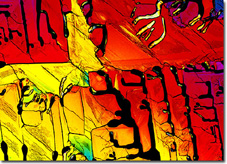Carotenoids


from http://micro.magnet.fsu.edu/micro/gallery.html
According to the UC Berkeley Wellness letter (Aug 1997), b-carotene,C40H56,shown above, is only one of dozens of beneficial carotenoids in foods. Carotenoids are a group of pigments containing carbon, hydrogen and sometimes oxygen. In leaves they often act as antenna molecules, absorbing light frequencies that chlorophylls cannot use. The energy is then transfered to the main center of photosynthesis. For some reason, these same pigments are synthesized in some roots and fruits. In the latter case it may be easier to explain their presence. While seeds are still immature, it is advantageous for the fruit to be inconspicuous and green in colour. If eaten at this point the plant would lose its progeny. The outer rind of, say, an immature orange, photosynthesizes while the plant's embryos develop. Afterwards, when the seeds are mature, it pays off for the fruit to advertise and increase its chances for seed dispersal. Thus the chlorophyll (which contains nitrogen) is digested, exposing the expendable the nitrogen-free carotenoids in ripe fruit.
Many of the carotenoids have vitamin A activity. They are antioxidants, removing free radicals that have been implicated in cancer, heart disease and aging.

an isomer of b-carotene, C40H56. Structurally very similar to b-carotene, the only difference being that its end rings are open. In decreasing order of importance, the best food sources from raw fruits and vegetables are:
a hydroxylated version of b-carotene
In decreasing order of importance, the best food sources are:(unit: mgper 100 grams)*According to the Merck index, the husk tomato is the richest source. Since most people do not eat the latter it could explain Berkeley's list.
 and zeaxanthin
and zeaxanthin (units: mg)
(units: mg)A violation of sig figs!!